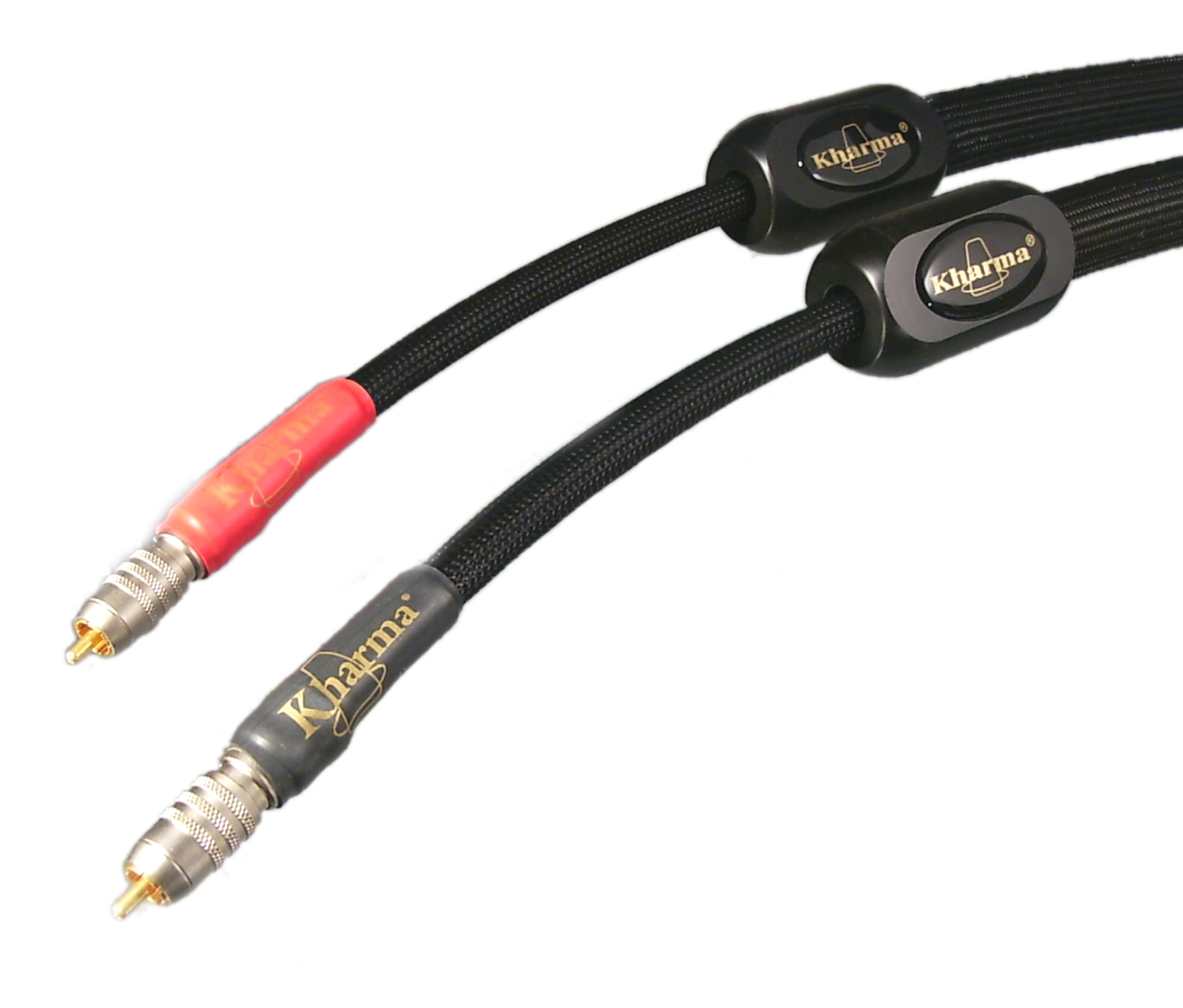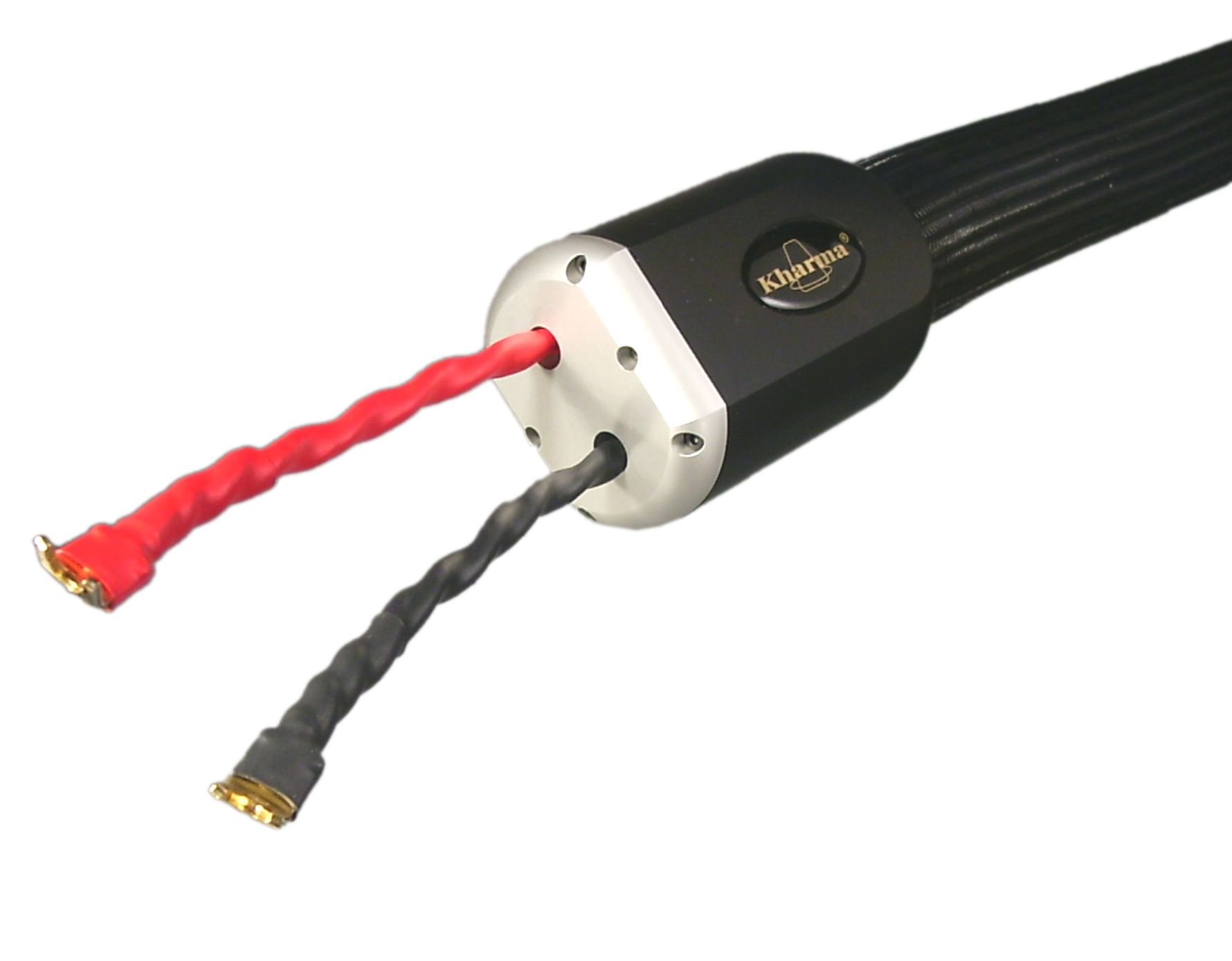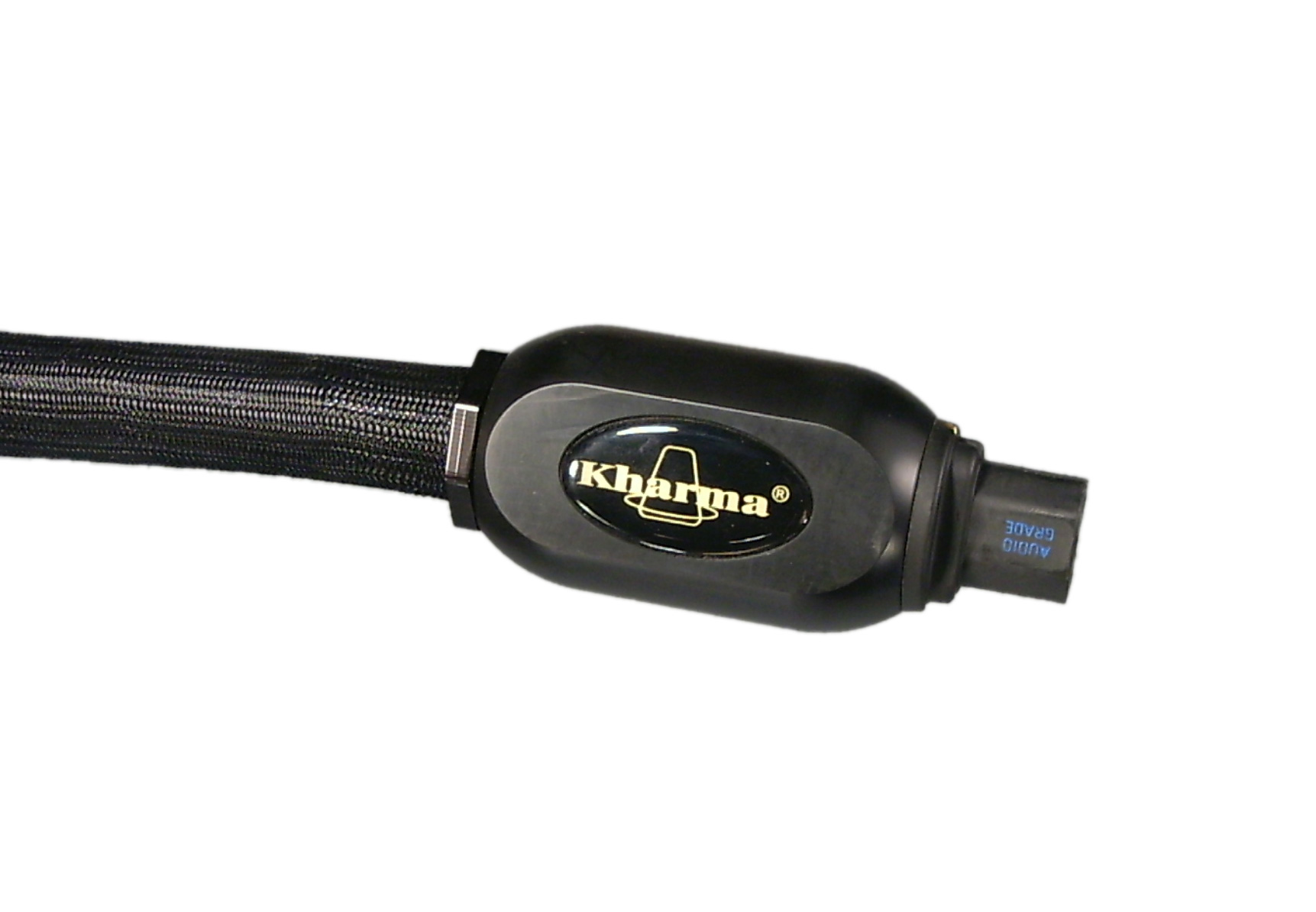KHARMA Grand Reference cables
|
“Tweakers Paradise” |
|
KHARMA Grand Reference cables
|
|
December 2003 |
|
Marshall Nack |
|
Specifications: Kharma Grand Reference Wire Specifications: Manufacturer Information:
The Kharma Grand Reference Speaker Wire
At the same volume setting, the orchestra came in even more softly, and slowly and very smoothly swelled, until it completely occupied the front of my room, just shy of my leaping for the volume control. Renée herself exhibited a similar new dynamic, but on a smaller scale. Her voice played with the melody as before, but traveled freely, seemingly unencumbered by system constraints. Furthermore, there were oodles of air supporting everything. The air, the agile, non-mechanical dynamics, and the high level of transparency, created an almost embarrassing inrush of intimacy and presence. We were all silenced for a few minutes. Then Bruce said he’d heard cable do the dynamic thing before: using an SPL meter at that time he had even measured the increase in dynamic range. Now remember, this is a speaker cable we’re talking about here, a passive device. When reading over this narrative, however, you’d think I was describing a SET amp with uncommonly good dynamics. The Kharma Grand Reference (GR) wires will do this to you: they’ll confound your assumptions and make you rethink the role of cables in a truly high-end system. Introductions I initially became acquainted with Kharma cables in the course of reviewing the YBA Passion 1000 mono amps. The 1000s were sounding dark with my wires, since my cable inventory tends to those with extra fullness and weight, so I needed something to lighten them up. Bill Parish, who provided the Passion 1000s and is also the North America importer and distributor for Kharma, said he had the Rx. One evening, he showed up with some demo interconnect and speaker wire. I gotta tell ya, when I saw what he pulled out of his bag, I nearly plotzed and spontaneously laughed for a few minutes. The GR speaker wire is HUGE – about 2” in diameter. The interconnect is about 1” in diameter and bigger in circumference and heavier in weight than either the Golden Sound Red or the Harmonic Tech Magic power cords. But when I heard what that wire did for Renée’s voice, I suggested a full GR review. When Bill came back sometime later with current versions, he arrived at my door lugging a dolly holding a wooden crate. Inside were a two-meter speaker cable, a one-meter and a two-meter interconnect and a one-meter digital! That’s all there was, and you needed a dolly to transport it! Again, I couldn’t contain myself, and broke into hysterical laughter. That you needed an amplifier-sized crate and a dolly to move some wires was just too far-gone. Indeed, if this was most audiophiles’ first reaction to the GR, what would normal folk make of them? I’m dwelling on this so you’ll be prepared when you encounter the cables. Build quality O.L.S. Audiotechnology, based in the Netherlands, is known primarily as the manufacturer of Kharma speakers. They also manufacture several complete lines of audio wires. The Kharma Grand Reference is their penultimate offering. As mentioned above, the GR line has been revised for the first time in five years. The same model designations are used, but all cables are now cryogenically treated and have cosmetically different plastic end caps and black sheaths. Build quality is impeccable and benchmarks the state-of-the-art. The main reason for the extraordinary bulk is that the large number of conductors (32 pure silver and gold individual wires) is housed in a massive vibration-reducing tube in which they float in individual air chambers. Air is a near-perfect dielectric. The air chambers in turn are sealed in a gel, so each conductor is isolated by air from other wires, and then isolated from most environmental factors by the gel-filled tube. To help support their weight, I try to drape the interconnects along the rack before connecting them to the RCA jacks. According to Kharma’s promo material, since speaker wires carry bigger Sounds Like Life Here we go again with the acid test. Having just returned from a Town Hall concert featuring the Guarneri String Quartet, I fired up the system. Now, to do a string quartet right is more of a challenge than you might think. The audiophile press is always going on about transients in relation to big decibel events (i.e., orchestral crescendos or loud “thwacks” on the kick drum). The string quartet is not one of those. It presents a narrow band of mostly mid-range frequencies with limited dynamic swings. Bounded by the cello’s open C string at about 65hz and the violin’s top note at about 2300hz, you shouldn’t hear any deep bass or very high treble. (Of course, there are overtones in these regions: I’m talking about the fundamental notes here.) Secondly, from the audiences perspective (and from a well-engineered recording’s perspective), the dynamic range produced by four string instruments goes from almost silence to medium loud: no huge fortes, please. I’ve saved the biggest challenge for last, which is the string tone itself, a well-known hi-fi problem area. Can the system handle this? A good system commonly misses on string tone and often messes up transient coherency, with some frequencies arriving earlier than others. Dynamics are sometimes exaggerated as well, so that the smaller forte of four instruments comes across like an entire string section. A better system gets the tone and maybe gets the transient, but usually exaggerates the bass, reproducing the cello’s low notes as if there’s an acoustic bass in the quartet. The GR is the only cable that gets it all correct. Just putting in the speaker cable went a long way to single-handedly fixing string tone and color by providing a wholly convincing overtone complement on this difficult material. There is an absolute lack of the hi-fi emphasis on frequency extremes often found in “exciting” cables. Plenty of detail is retrieved, like the rosiny texture of the strings, but it’s never at the expense of the strings’ tone or the overall picture. A vanishingly low noise level underwrites this high detail retrieval: There’s simply a lot of unvarnished signal coming through, presented in an unaggressive manner. The small scale of the quartet is preserved, and HUGE helpings of air, presence, and natural dynamics make it as interesting and compelling in its way as Renée on the Bel Canto CD. Check out the vibraphone on Swingin’ and Burnin’, featuring the John Cocuzzi Quintet [Wildchild! MS 06652], a collection of some good, old-fashioned, small group swing tunes. On track two, ‘Broadway’, the guitar enters first, and excites the snare drum, which you hear across the room. Then you’re caught off-guard by the brilliant entrance of the vibraphone. The almost fierce strike of the mallet, the waves of resonance rolling off the steel bars, the decay trails that ring longer and more naturally: all is self-evident. And the tune rolls right along, with you in the audience having a good time. By the way, this is a vintage vibe with iron bars, not a modern instrument that uses aluminum. It sounds different, and that sound is preserved on this excellently engineered disc. These cables sound like life. In the area of body and fullness there’s realistic bloom, but no fat. If anything, it might be a little leaner than neutral. This characteristic is key to the GR’s expressiveness, enabling the clarity that lets you hear all those little nuances and details and the huge quantity of air. It also means these wires mate best with full-bodied components. Avoid lean-sounding gear. It’s been several months since I reviewed the YBA Passion 1000 mono blocks, but the guys still talk about the sound I got when I connected the Passion 1000s to my EgglestonWorks Rosa speakers using Kharma GR wires. The Rosas and the 1000s are both full sounding, and this was a match made in heaven. Grand Reference Power Cord The GR AC power cords arrived late in the audition. They are about the same girth as the interconnects (that was a relief: I was afraid they would be closer to the speaker cable), but more flexible. Again, class A+ construction. What occurred when I inserted the GR PCs made me think something had happened to the digital bit-stream to fill in the gaps between the bytes. Texture became less granular, more analog-like and the stage seemed more continuous from left to right and front to back. Instead of isolated individual images, the musicians appeared to be occupying the same space and time, the same stage. The grey sound of some CDs was gone and new colors appeared. Burn-in took the usual 100 or so hours, accompanied by the usual tonal shift from dark to the final state, which was tonally in between the Golden Sound PCs: darker and more full bodied than the Blue, but lighter and less weighty than the Red, and also lighter than the Harmonic Tech Magic PC. This translates into the Grand Reference PC being probably the best mate for source level gear (front-ends and pre-amp) that you’re going to find. Conclusion Upon first glimpsing the Kharma Grand Reference cables most people’s reaction is incredulity at their bulk. Lacking an appropriate response, laughter probably comes next. But laughter always turns to awe and admiration after the first A/B demo. There’s nothing subtle about the wholesale gains in presence and air, let alone natural dynamics. The audience for these cables will be the audiophile with an upper-end system who is familiar with cable effects. Be prepared to have your assumptions challenged. You want to feel like the musicians are in the room in a realistic, unforced manner? Given a suitably full-bodied system, which will almost certainly contain tubes, the GR cables are your ticket. I put Kharma Grand Reference cables in a class of their own: nothing else I’ve heard sounds like them.
|
|
|
Stereo Times Masthead
Publisher/Founder
Clement Perry
Editor
Dave Thomas
Senior Editors
Frank Alles, Mike Girardi, Russell Lichter, Terry London, Moreno Mitchell, Paul Szabady, Bill Wells, Mike Wright, and Stephen Yan,
Current Contributors
David Abramson, Tim Barrall, Dave Allison, Ron Cook, Lewis Dardick, John Hoffman, Dan Secula, Don Shaulis, Greg Simmons, Eric Teh, Greg Voth, Richard Willie, Ed Van Winkle, Rob Dockery, Richard Doran, and Daveed Turek
Site Management Clement Perry
Ad Designer: Martin Perry









Be the first to comment on: KHARMA Grand Reference cables